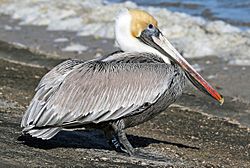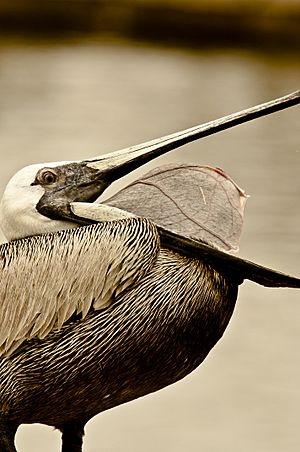Brown pelican facts for kids
Quick facts for kids Brown pelican |
|
|---|---|
 |
|
| Brown pelican | |
| Conservation status | |
| Scientific classification | |
| Kingdom: | |
| Class: | |
| Order: | |
| Family: | |
| Genus: | |
| Binomial name | |
| Pelecanus occidentalis Linnaeus, 1766
|
|
The brown pelican (Pelecanus occidentalis) is a large bird that lives along the coasts of the Atlantic, Pacific Ocean, and Gulf of Mexico in North and South America.
Brown pelicans are meat-eaters, also known as carnivores. They hunt during the day, meaning they are diurnal. Their diet mainly consists of fish, but they also eat some amphibians and crustaceans.
Contents
About the Brown Pelican
The brown pelican is the smallest of the eight types of pelicans. Even so, it is still a very large bird. It can be about 106–137 cm (42–54 in) long. These birds weigh from 2.75 to 5.5 kg (6.1 to 12.1 lb). Their wingspan can reach from 1.83 to 2.5 m (6.0 to 8.2 ft) wide.
What Does a Brown Pelican Look Like?
It is easy to spot a brown pelican in most places it lives. Like all pelicans, this bird has a very big bill. Its bill is about 28 to 34.8 cm (11.0 to 13.7 in) long. It has a special pouch underneath its bill called a gular pouch. This pouch helps drain water when the pelican scoops up its food.
The head of an adult brown pelican is white. It often looks a bit yellowish. The bill is usually grayish. However, when pelicans are ready to breed, the underside of their throat turns reddish. Their back, rump, and tail have streaks of gray and dark brown. Sometimes these parts can look a bit rusty. The chest and belly of adult pelicans are blackish-brown. Their legs and feet are black. Young pelicans look similar but have a brownish-gray neck and white underparts.
How is it Different from Other Pelicans?
The brown pelican is easy to tell apart from the American white pelican. The white pelican is, as its name suggests, white. The brown pelican is also smaller. Brown pelicans dive from the air to catch fish. White pelicans, however, work together to catch fish while swimming on the water's surface.
The Peruvian Pelican used to be thought of as a type of brown pelican. Now, scientists know it is a separate species. It looks very much like the brown pelican. But the Peruvian pelican is much bigger. Brown and Peruvian pelicans might live in the same areas along the Pacific coast of South America.
Where Brown Pelicans Live
Brown pelicans live on both the Atlantic and Pacific coasts of the Americas.
Atlantic and Gulf Coasts
Along the Atlantic Coast and Gulf Coast, they live from Nova Scotia in Canada all the way to Venezuela. They can even be found near the mouth of the Amazon River. North of the Carolinas, they are less common. But there are many brown pelicans in the Gulf of Mexico.
Pacific Coast
On the Pacific Ocean, they live from British Columbia in Canada down to south-central Chile. They also live in the Galápagos Islands. Along the coasts of California, Mexico, and Central America, they are quite common.
Migration and Habitats
Some young birds might fly to freshwater lakes inland. After nesting, North American birds move in groups further north along the coasts. They return to warmer waters for winter. Brown pelicans are also often found in mangrove swamps.
Brown Pelican Behavior
Pelicans are very social birds. They live in groups with both males and females all year long. They float very well on water. This is because they have air sacs under their skin and in their bones. They are graceful when flying but can be clumsy on land.
Flying and Hunting
When flying, pelicans often fly in lines or single file. Their heads are held back on their shoulders. Their bills rest on their folded necks. They often fly low over the water.
When looking for food, pelicans fly a few feet or even higher above a group of fish. Then, they dive very fast into the water. They often go completely underwater for a moment to grab their prey. When they come back up, they let the water drain from their throat pouch before swallowing the fish. Only the Peruvian Pelican hunts in this active diving way. Other pelicans usually scoop up fish while swimming on the water's surface. Young brown pelicans have been seen trying to scoop fish while swimming, like other pelican types. Sometimes, other birds like gulls or frigatebirds try to steal food from pelicans. This is called kleptoparasitism.
What They Eat
Brown pelicans mostly eat fish. But sometimes they also eat amphibians or crustaceans, like prawns. In some areas, fish like Menhaden can make up almost all of their diet. The amount of anchovy fish is very important for how well brown pelicans can nest. However, the fish they prefer to eat are usually not the ones caught by commercial fishermen. Other fish they eat include pigfish, pinfish, herring, sheepshead, silversides, mullet, and minnows. A single adult pelican can eat up to 1.8 kg (4.0 lb) of food every day. Today, in many coastal areas, brown pelicans hang around fishing ports and piers. They hope to be fed or to steal fish scraps, especially if people have fed them before.
Reproduction and Life Cycle
Brown pelicans build their nests in large groups called colonies. They often choose islands or mangrove trees for nesting. Male pelicans choose the nesting spots. They do a special "advertising" display to attract females. Once a pair forms, they don't communicate much with each other.
Nesting and Chicks
Pelican nesting is busiest in March and April. Nests are built in trees, bushes, or on the ground. Ground nests are usually on islands where land animals cannot reach them. Nests in trees are often not very strong. They are made of reeds, grasses, straw, and sticks. Ground nests are shallow scrapes lined with feathers. They have a rim of soil built about 10–26 cm (3.9–10.2 in) above the ground.
Brown pelicans usually lay about 2 to 3 eggs. The chicks hatch naked and helpless. The eggs hatch after about 28 to 30 days. Both parents take good care of their young. Young pelicans in ground nests start walking on their own at about 35 days old. Chicks in treetop nests stay there longer, up to 68 to 88 days. For 8 to 10 months, the parents feed their young by bringing up food from their stomachs. A young pelican can eat about 70 kg (150 lb) of fish during this time.
Growing Up
Young pelicans become adults and can have their own babies when they are two to five years old. At this age, they also get their full adult feathers.
Dangers to Young Pelicans
Sometimes, predators attack pelican colonies. Animals that might eat eggs, young, or rarely, adult pelicans include gulls, raptors (like bald eagles), foxes, skunks, and wild cats. In places where they live near each other, American alligators might catch young pelicans learning to fly. If a colony is on an island, there are usually fewer predators.
Brown pelicans are very sensitive to people disturbing their nests. If tourists or fishermen bother them, they might leave their nests. Because adult pelicans are so big, they are rarely hunted by other animals when they are not nesting.
Protecting Brown Pelicans
In the early 1970s, chemicals like DDT and dieldrin were a big threat to brown pelicans. These chemicals were used in the southeastern United States and California. They also threatened pelicans in Florida.
The DDT Problem
Researchers found that DDT made pelican eggshells too thin. The eggs could not hold the baby pelican until it was ready to hatch. Because of this research, DDT was banned in Florida, and then in the rest of the US. The brown pelican, along with the American white pelican, is now protected by the Migratory Bird Treaty Act of 1918.
Current Status
The International Union for Conservation of Nature (IUCN) has listed the brown pelican as "Least Concern" since 1988. This means they are not currently at high risk of disappearing. After the US government banned DDT in 1972, the number of brown pelicans grew. Today, there are an estimated 650,000 brown pelicans.
Brown Pelicans in Culture
In the children's movie Finding Nemo, there is a friendly talking pelican named Nigel. He was voiced by Geoffrey Rush. The movie is set near Australia, but only the white Australian pelican lives there, not the brown pelican.
Interesting facts
- The brown pelican is the official state bird of Louisiana, earning it the nickname "The Pelican State." It's even featured on the state flag and seal!
- The National Basketball Association team, the New Orleans Pelicans, is named after Louisiana's state bird.
- While they make some grunting noises at their nests, adult brown pelicans are generally silent birds.
- The colors on a pelican's head and neck can change during breeding season, becoming more vibrant with shades of reddish-brown and yellow, signaling their readiness to mate.
- The brown pelican is one of the mascots for Tulane University. It is also on the seals of Tulane University, Louisiana State University, and the University of Louisiana at Lafayette. You can also see it on the Crest of the University of the West Indies.
- It is the national bird of Barbados and the Turks and Caicos Islands.
Images for kids
-
Adult in flight, Bodega Bay, California
-
immature P. o. carolinensis, Panama
-
Aerial view of the Pelican Island National Wildlife Refuge
-
An adult brown pelican with a chick on a nest on Smith Island, Chesapeake Bay, Maryland, USA
-
Juvenile brown pelican in flight, Bodega Head, California
See also
 In Spanish: Pelícano pardo para niños
In Spanish: Pelícano pardo para niños











